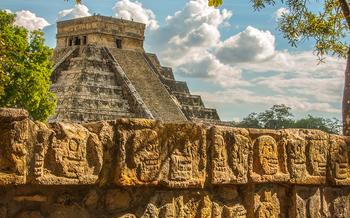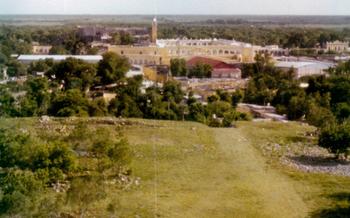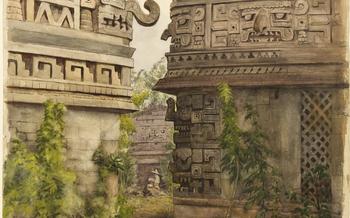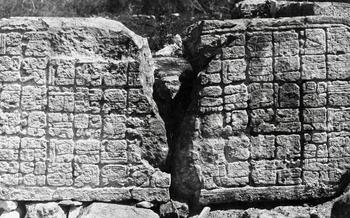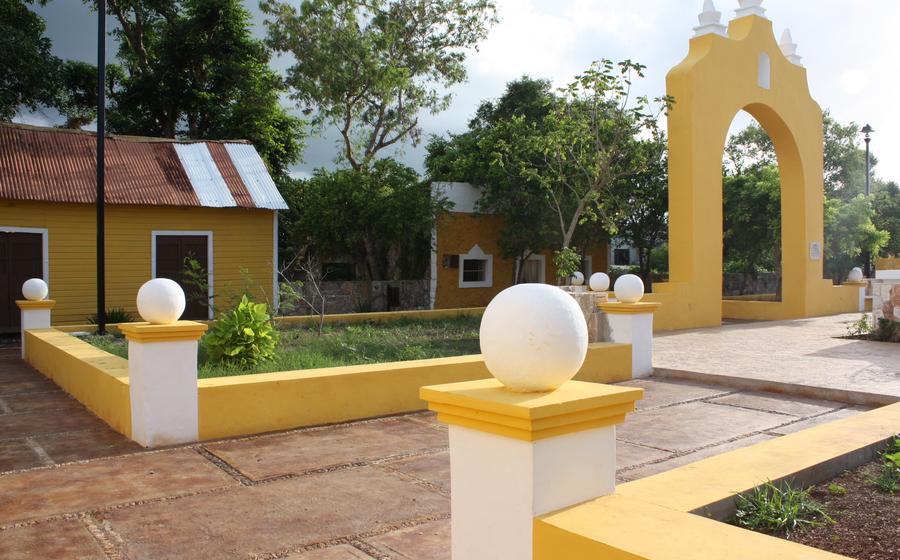
Cenote San Antonio (Nearby city)
- Izamal: City of Convents and Cenotes
- Cenote San Antonio: A Hidden Gem
- Getting to Cenote San Antonio
- What to Bring to Cenote San Antonio
- Tips for Visiting Cenote San Antonio
- Exploring the Cenote San Antonio Grounds
- Swimming and Snorkeling in Cenote San Antonio
- Cenote San Antonio for Photography Enthusiasts
- Other Activities at Cenote San Antonio
- Cenote San Antonio for Families
- Cenote San Antonio for History Buffs
- Cenote San Antonio for Nature Lovers
- Cenote San Antonio for Relaxation and Wellness
- Insider Tip: Cenote San Antonio Secret Spot
Izamal: City of Convents and Cenotes
Izamal, a city located in the heart of the Yucatan Peninsula in Mexico, offers a captivating blend of history, culture, and natural wonders. Founded by the Mayans, Izamal was later conquered by the Spanish in the 16th century, leaving behind a legacy of stunning colonial architecture, including the iconic Convent of San Antonio de Padua, the largest in the Americas. The city's vibrant yellow buildings, a result of a local tradition, have earned it the nickname "The Yellow City."
Beyond its architectural treasures, Izamal boasts a wealth of cenotes, natural sinkholes filled with crystal-clear water, inviting visitors to explore the region's unique underground world. These cenotes, scattered throughout the Yucatan Peninsula, offer opportunities for swimming, snorkeling, diving, and spelunking. Among the most popular cenotes near Izamal is Cenote San Antonio, a hidden gem that promises an unforgettable adventure.
Cenote San Antonio: A Hidden Gem
Location and access to Cenote San Antonio:
Cenote San Antonio is a hidden gem located just a short drive from the charming city of Izamal in Mexico. To get to the cenote, you can either take a taxi or rent a car. The drive from Izamal takes about 30 minutes, and the road is well-maintained. Once you arrive at the cenote, you will need to pay a small entrance fee.
What to expect at Cenote San Antonio:
Cenote San Antonio is a beautiful and secluded cenote that is perfect for swimming, snorkeling, and relaxation. The cenote is surrounded by lush vegetation, and the water is crystal clear. There are several platforms and ladders that you can use to get into the cenote, and there are also life jackets available for rent.
Swimming and snorkeling in Cenote San Antonio:
The water in Cenote San Antonio is perfect for swimming and snorkeling. The water is clear and refreshing, and there are plenty of fish and other marine life to see. The cenote is also relatively shallow, so it is a good option for families with young children.
The unique features of Cenote San Antonio:
Cenote San Antonio is a unique cenote in that it has two different levels. The upper level is a large, open cenote with a depth of about 20 feet. The lower level is a smaller, more secluded cenote with a depth of about 40 feet. The lower level is accessible by a narrow tunnel, and it is a great place to go for a swim or snorkel.
Getting to Cenote San Antonio
Transportation options from Izamal to Cenote San Antonio:
There are several ways to get from Izamal to Cenote San Antonio, depending on your budget and time constraints. The most convenient option is to take a taxi, which should cost around $15-20 USD. You can also take a bus, which costs around $2-3 USD, but it takes longer and may require you to transfer buses. If you're feeling adventurous, you can rent a bike and cycle to the cenote, which takes about 30 minutes.
Driving directions to Cenote San Antonio:
If you're driving to Cenote San Antonio, take the following directions:
- From Izamal, take Highway 180 east towards Valladolid.
- After about 15 kilometers, turn left onto Calle 20.
- Follow Calle 20 for about 5 kilometers until you reach the small town of San Antonio.
- Turn left at the town square and follow the signs to the cenote.
Parking at Cenote San Antonio:
There is a small parking lot at Cenote San Antonio where you can park your car or bike. The parking fee is $2 USD.
Cost of admission to Cenote San Antonio:
The cost of admission to Cenote San Antonio is $10 USD for adults and $5 USD for children. This includes access to the cenote, as well as changing rooms, showers, and lockers.
What to Bring to Cenote San Antonio
When packing for your trip to Cenote San Antonio, there are a few essential items to keep in mind. Swimwear is a must, as you'll want to take advantage of the opportunity to swim and snorkel in the cenote's crystal-clear waters. Water shoes are also recommended to protect your feet from the rocky bottom of the cenote.
If you plan on doing some serious snorkeling, you may want to bring your own snorkeling gear. However, you can also rent snorkeling equipment at the cenote. For those who want to capture the beauty of the cenote, a waterproof camera is a must.
Don't forget to bring sunscreen, sunglasses, and a hat to protect yourself from the sun's harmful rays. Towels are also essential for drying off after your swim.
Finally, be sure to bring snacks and drinks to keep you energized throughout your visit. You can either bring your own food and drinks or purchase them at the cenote's restaurant.
Tips for Visiting Cenote San Antonio
To make the most of your visit to Cenote San Antonio, keep the following tips in mind:
- Best time to visit: The best time to visit Cenote San Antonio is during the dry season, which runs from November to April. During this time, the weather is sunny and dry, and the cenote's water levels are at their lowest.
- Avoiding the crowds: Cenote San Antonio can get crowded, especially during the peak tourist season. To avoid the crowds, visit the cenote early in the morning or late in the afternoon.
- Safety precautions: Cenote San Antonio is a safe place to swim and snorkel, but there are a few safety precautions to keep in mind. Be sure to wear water shoes to protect your feet from the sharp rocks, and don't swim or snorkel alone.
- Etiquette: Be respectful of other visitors and the cenote's environment. Don't litter, and keep your voice down.
Exploring the Cenote San Antonio Grounds
Cenote San Antonio is not just a place to swim and snorkel; it's also a beautiful and unique natural setting that's worth exploring. The cenote is surrounded by lush vegetation, including towering trees, tropical flowers, and ferns. The air is filled with the sound of birdsong and the rustling of leaves.
Cenote's Natural Beauty The cenote's crystal-clear waters reflect the lush vegetation, creating a stunning visual effect. The water is so clear that you can see all the way to the bottom, where you'll see a variety of underwater plants and animals. The cenote is also home to a variety of birds, including parrots, toucans, and hummingbirds.
Cenote's Unique Features One of the most unique features of Cenote San Antonio is its two chambers. The first chamber is a large, open cenote with a high ceiling. The second chamber is smaller and narrower, with a lower ceiling. The two chambers are connected by a narrow tunnel.
Cenote's Surrounding Vegetation The cenote is surrounded by a lush tropical forest, which provides a habitat for a variety of plants and animals. The forest is home to a variety of trees, including mahogany, cedar, and rosewood. The forest is also home to a variety of animals, including monkeys, sloths, and toucans.
Cenote's Wildlife The cenote is home to a variety of aquatic life, including fish, turtles, and frogs. The cenote is also home to a variety of birds, including parrots, toucans, and hummingbirds. The forest surrounding the cenote is home to a variety of animals, including monkeys, sloths, and toucans.
Swimming and Snorkeling in Cenote San Antonio
Cenote San Antonio boasts crystal-clear waters that offer excellent visibility for swimming and snorkeling. The cenote's waters are also refreshing and cool, making it an ideal place to escape the heat and humidity of the Yucatan Peninsula.
The cenote's diverse marine life includes a variety of fish, turtles, and other aquatic creatures. Snorkelers can explore the cenote's underwater caves and tunnels, which are home to a variety of colorful corals and sponges.
The cenote's swimming and snorkeling conditions are generally good, with calm waters and no strong currents. However, it is important to be aware of the cenote's depth, which can range from 10 to 20 feet.
Tips for Swimming and Snorkeling in Cenote San Antonio:
- Bring your own snorkel gear or rent it from a local shop.
- Wear water shoes or sandals to protect your feet from the cenote's rocky bottom.
- Be aware of the cenote's depth and avoid diving into shallow areas.
- Do not touch or disturb the cenote's marine life.
- Be respectful of other swimmers and snorkelers.
Cenote San Antonio for Photography Enthusiasts
Cenote San Antonio is a dream come true for photography enthusiasts. With its picturesque surroundings, unique lighting conditions, and diverse photo opportunities, this cenote is a haven for capturing stunning images. The cenote's crystal-clear waters, lush vegetation, and dramatic rock formations create a visually captivating scene that will leave you in awe.
The unique lighting conditions at Cenote San Antonio make it possible to capture stunning photos at any time of day. The cenote's waters reflect the sunlight, creating a dazzling display of colors and patterns. The cenote's surrounding vegetation also provides a variety of photo opportunities, from the vibrant green of the trees to the delicate flowers that bloom along the cenote's edge.
The cenote's diverse photo opportunities make it a great place to experiment with different photography techniques. The cenote's crystal-clear waters allow for stunning underwater photography, while the surrounding vegetation provides opportunities for macro photography. The cenote's dramatic rock formations also make for great landscape photography.
Here are a few tips for taking photos at Cenote San Antonio:
- Use a waterproof camera or housing to protect your equipment from the water.
- Bring a tripod to stabilize your camera for long exposure shots.
- Use a polarizing filter to reduce glare and reflections.
- Experiment with different shutter speeds to capture the movement of the water.
- Take advantage of the cenote's unique lighting conditions to create stunning photos.
Other Activities at Cenote San Antonio
In addition to swimming and snorkeling, there are several other activities that you can enjoy at Cenote San Antonio.
Kayaking and Paddleboarding
For a more active experience, you can rent a kayak or paddleboard and explore the cenote's crystal-clear waters. This is a great way to get up close and personal with the cenote's unique rock formations and diverse marine life.
Cliff Jumping
For those who are feeling adventurous, there are several cliffs of varying heights that you can jump from into the cenote's refreshing waters. This is a thrilling experience that is sure to get your adrenaline pumping.
Hiking and Nature Walks
The cenote is surrounded by lush tropical vegetation, making it a great place for hiking and nature walks. There are several trails that you can follow, which will take you through the jungle and offer you stunning views of the cenote and the surrounding countryside.
Birdwatching
The cenote is home to a variety of bird species, making it a great place for birdwatching. You can spot several different types of birds, including parrots, toucans, and hummingbirds.
Cenote San Antonio for Families
Cenote San Antonio is a great place for families with children of all ages. The cenote's shallow areas and gentle slopes make it easy for kids to swim and play safely. Life jackets and other safety equipment are also available for rent.
In addition to swimming, there are plenty of other activities to keep kids entertained at Cenote San Antonio. They can explore the cenote's caves and tunnels, jump off the cliffs, or go for a hike in the surrounding jungle. There are also several restaurants and snack bars nearby where families can grab a bite to eat.
Here are some tips for visiting Cenote San Antonio with kids:
- Bring plenty of sunscreen, hats, and sunglasses to protect your kids from the sun.
- Wear water shoes to protect your feet from the sharp rocks.
- Bring a change of clothes for your kids in case they get wet.
- Be sure to supervise your kids at all times, especially when they are swimming or exploring the cenote's caves and tunnels.
- Take breaks throughout the day to rest and hydrate, especially if you are visiting the cenote during the hot summer months.
Cenote San Antonio for History Buffs
History and Cultural Significance
Cenote San Antonio holds significant historical and cultural importance. It was once a sacred site for the ancient Mayans, who believed that cenotes were portals to the underworld. Archaeological evidence suggests that the cenote was used for ceremonial purposes, and several artifacts, including pottery and jewelry, have been found in its depths.
In the 16th century, Spanish conquistadors arrived in the region and built a church near the cenote. The church, which is still standing today, is a testament to the region's rich colonial history. Cenote San Antonio continued to be an important site for religious rituals and ceremonies throughout the colonial period.
Today, Cenote San Antonio is a popular destination for visitors interested in learning about the region's history and culture. The cenote's ancient Mayan ruins and the nearby church offer a glimpse into the past, while the cenote's natural beauty and cultural significance make it a unique and unforgettable destination.
Cenote San Antonio for Nature Lovers
Cenote San Antonio is a haven for nature lovers, offering a glimpse into the region's rich biodiversity. The cenote's crystal-clear waters are home to a variety of aquatic plants and animals, including colorful fish, turtles, and even crocodiles. The surrounding vegetation is equally diverse, with lush tropical plants and towering trees providing a habitat for a variety of birds, insects, and other wildlife.
One of the most unique features of Cenote San Antonio is its underwater cave system. These caves are home to a variety of blind cave fish and other unique creatures that have adapted to life in the darkness. Visitors can explore these caves with a guided tour, which provides a fascinating glimpse into the hidden world beneath the cenote's surface.
Cenote San Antonio is also an important site for birdwatching. The cenote's surrounding trees and vegetation provide a habitat for a variety of resident and migratory birds, including parrots, toucans, and woodpeckers. Visitors can often spot these birds from the cenote's viewing platforms or while exploring the surrounding trails.
The cenote's management is committed to preserving the cenote's natural beauty and biodiversity. They have implemented a number of conservation measures, including limiting the number of visitors, prohibiting the use of chemicals and sunscreen in the cenote, and working with local communities to protect the surrounding environment.
Cenote San Antonio for Relaxation and Wellness
Cenote San Antonio is not just a place for adventure and exploration; it's also a place for relaxation and rejuvenation. The cenote's tranquil atmosphere and healing waters make it an ideal destination for those seeking a peaceful retreat.
Float in the cenote's crystal-clear waters and let your worries melt away. The water's high mineral content is said to have therapeutic properties, making it ideal for soothing sore muscles and joints.
Indulge in a massage or spa treatment at the cenote's on-site spa. The spa offers a variety of treatments, including massages, facials, and body wraps.
Take a yoga or meditation class in the cenote's tranquil surroundings. The cenote's natural beauty and peaceful atmosphere make it an ideal place to connect with your inner self.
Insider Tip: Cenote San Antonio Secret Spot
If you're looking for a truly unforgettable experience, be sure to seek out Cenote San Antonio's secret spot.
This hidden gem is located just a short walk from the main cenote, but it feels like a world away.
The secret spot is a small, secluded swimming hole with crystal-clear water and lush vegetation. It's the perfect place to relax and soak up the sun, or to take a refreshing dip in the cool water.
To find the secret spot, simply follow the path that leads away from the main cenote. After a few minutes, you'll come to a small clearing. The secret spot is located on the right-hand side of the clearing.
Once you've found the secret spot, you'll be rewarded with stunning views of the surrounding jungle.
This is also a great place to take photos, as the light is often perfect for capturing the beauty of the cenote.
So, if you're looking for a unique and unforgettable experience, be sure to add Cenote San Antonio's secret spot to your itinerary.

